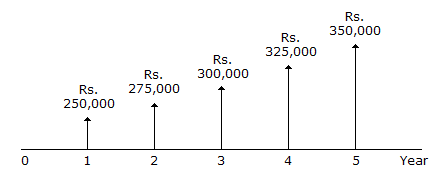Civil Engineering :: Engineering Economy
-
Which one of the following questions is relevant to the construction estimates :
-
The ratio obtained by dividing 'quick assests' by current liabilities is called
-
Which one of the following definitions, is correct ?
-
Pick up the element of the cost from the following:
-
Pick up the correct statement from the following:
-
Which one of the following is included in financial ratios of the firm ?
-
Pick up the correct statement from the following:
-
Refer to the cash flow diagram of uniform gradient in a cash flow (in the given figure), the gradient is :

-
In the cash-flow diagram shown in the given figure

-
The estimate based on a detailed quantity survey and furnishes the most accurate and reliable estimate possible is known as
|
A.
The ratio of total debt to share holder's equity is called 'debt ratio'.
|
|
B.
The ratio debt-to-total assests is called Debt-to-total assest ratio.
|
|
C.
The ratio of earnings before interest and taxes for a particular reporting period to the amount of interest charges for the period, is called interest coverage ratio.
|
|
D.
All of these
|
|
A.
The change in the amount of money over a given time period is called 'time value' of money, a most important concept in engineering economy.
|
|
B.
The manifestation of the time value of money is termed as interest.
|
|
C.
Interest on borrowing = present amount owed - original loan
|
|
D.
The original investment (or loan) is referred to as principal.
|
|
E.
All of these.
|
|
A.
The financial ratio summarises some aspect of the firm's financial condition at the time of preparing a balance sheet.
|
|
B.
Both the numerator and denominator of financial ratios come directly from the balance sheet.
|
|
C.
Income statement ratios compare one 'flow' item from the income statement to another flow item from the income statement.
|
|
D.
Income statement ratios compare a flow item from the income statement to another flow item form the income statement
|
|
E.
All of these
|


 Whatsapp
Whatsapp
 Facebook
Facebook

